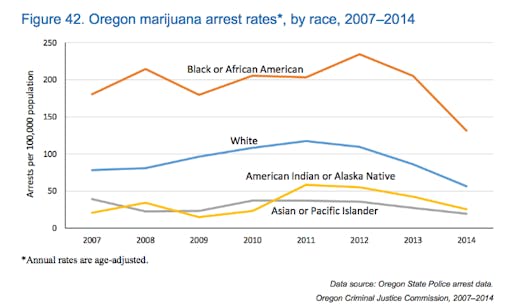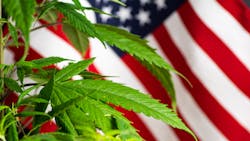When we first put humans into capsules and shot them into space, we weren’t exactly sure what would happen. So with electrodes and blood-pressure cuffs we meticulously tracked astronauts’ vital signs as they ventured into the unknown.
The same thing, in a sense, is happening in Oregon. As the state blasts into the cannabis frontier — recreational markets opened Oct. 1 — officials want to keep tabs on the vitals. This month the Oregon Health Authority published its first-ever report on cannabis use by residents, full of brightly colored charts and detailed demographic information. It’s meant to be a snapshot of attitudes and behaviors at the dawn of a new era.
“The purpose of this report was not to lay out any policy,” Oregon’s state health officer and epidemiologist, Katrina Hedberg, told Leafly. “The policy is being discussed, and I believe strongly that it’s important to ground that in data.”
Hedberg, who oversaw the report’s production, said at least one takeaway is clear: Oregon loves its cannabis. In the past decade, while consumption in the rest of the nation rose just a smidge, the percentage of Oregonians 25 and older who use cannabis regularly has more than doubled. It stands at 11 percent, according to the latest available numbers, much higher than the U.S. average of 7 percent. “There are different attitudes out here in the Pacific Northwest,” Hedberg said.
A grain of salt: Those numbers, from 2013, already are stale. More current surveys suggest adult use nationally had climbed to 11 percent by mid-2015. And the most recent numbers from Colorado, where cannabis is also legal, show 13.6 percent of adults consume regularly — a big increase from less than 8 percent reported back in 2012. Given how fast the cannabis landscape is changing, how much should people trust the report’s numbers?

“I don’t think that anybody should look at these figures and say, ‘Aha!’” Hedberg said. The health authority plans to release reports annually, with certain data being updated more often. “It’s less about what’s the absolute number and more about what are the trends.”
Trend-wise, it’s safe to say more Oregon adults are using cannabis. But what about the kids? Most adults surveyed said they worried legalization would boost underage consumption. Has it? No.
Use among young people in the state has actually fallen in recent years, both in absolute terms and with respect to the rest of the country. Nine percent of surveyed eighth graders and 19 percent of 11th graders had used cannabis within the past 30 days, the report found.

Oregon’s data add to the limited but growing evidence that more tolerant policies on adult use don’t translate to higher rates among teens. Plenty of eyes will be watching those numbers.
Another promising sign: Cannabis arrests have plummeted. Possession charges dropped by more than half between 2011 and 2014, from 4,223 to 2,109. In 2011, an average of 140 people out of 100,000 were arrested on cannabis charges. By 2015, that fell to about 36.
Shop highly rated dispensaries near you
Showing you dispensaries nearUnfortunately, racial disparities are still striking. In 2014, black or African-American Oregonians were 2.3 times more likely than whites to be arrested on cannabis charges. That difference, the report notes, “did not significantly change from 2007 to 2014.” There may be good reasons to believe legalization can address racial inequality, but Oregon has yet to see it.

Driving remains another sticking point, both for youth and adults. Nearly half of 11th graders who use cannabis reported driving within three hours of consumption. And roughly two-thirds of adults, 63 percent, said they didn’t know when it’s legal to drive after using cannabis. Seventy-five percent of adults, however, agreed that driving under the influence increases the risk of a crash.
Sixty-two percent of eighth graders said they have easy access to cannabis, reporting that it’s easier to obtain than cigarettes but harder to get than alcohol. Whether they actually want cannabis is another story: Not only are fewer kids choosing to consume, they’re also more concerned about its dangers. Health fears among students in Oregon were greater after legalization, in 2015, than they were just two years before. (Separate data, from the federal Substance Abuse and Mental Health Services Administration, indicate teens nationwide are actually less concerned about health risks than they were in 2010. That survey, however, polled students about monthly use, while Oregon asked about weekly use.)
One of the biggest challenges for policymakers, Hedberg said, is trying to educate kids about the potential consequences of cannabis use without resorting to war-on-drugs–era scare tactics.
“There are a number of studies to show that, at least for young, developing brains still in high school, regular use is not going to be beneficial for them,” she said. “How do you give a message about moderation that doesn’t say the sky is falling?”
Breaking down Oregonians’ use by demographics, the survey found some groups stood out. Lesbian, gay, and bisexual adults used cannabis at nearly three times the rate of straight respondents — 30 percent to 11 percent, respectively. People with disabilities also consumed at a slightly higher rate (14 percent), though the report didn’t clarify how much of the use was for medical reasons. Only 6 percent of veterans said they were current users, roughly half the rate of the general population.
Medical patients made up less than a third of total adult users, with 3 percent of all surveyed adults identifying as patients. Most who did apply for a medical card were approved. On average, only 4 percent of applications since 2001 were rejected.
So what does it all mean? Is the Oregon Health Authority a friend to cannabis, or a foe? Hedberg says neither. “At this point, we actually tried pretty hard in this for the report to have just the facts and not to spend a lot of time talking about policy implications,” she said.
A government body making decisions about cannabis based on facts? How refreshing.





